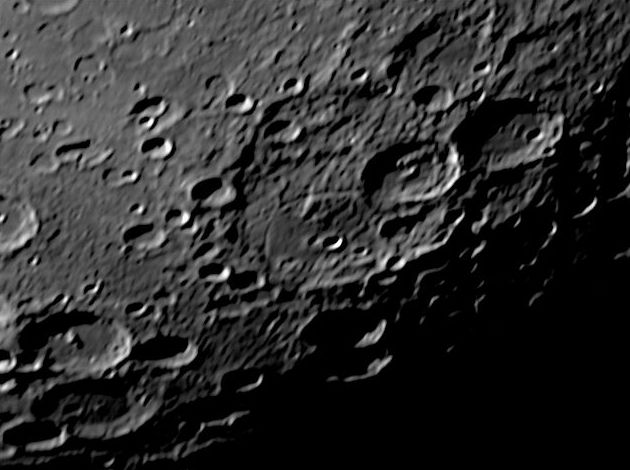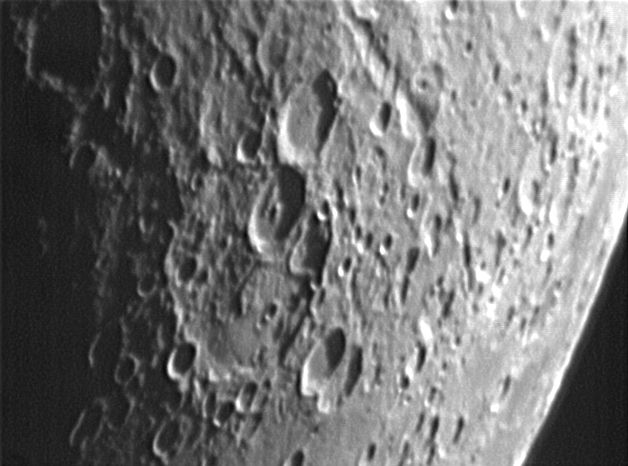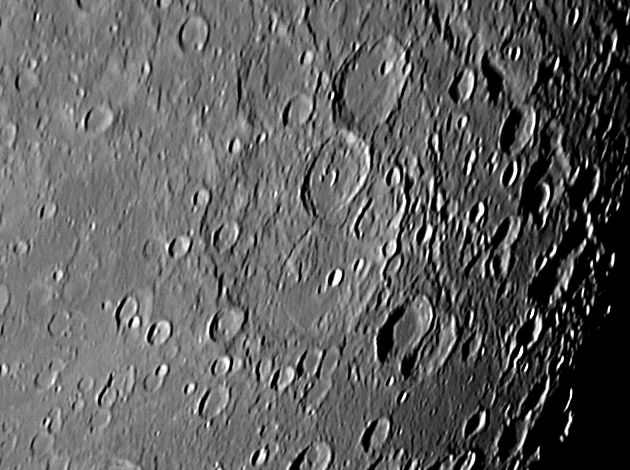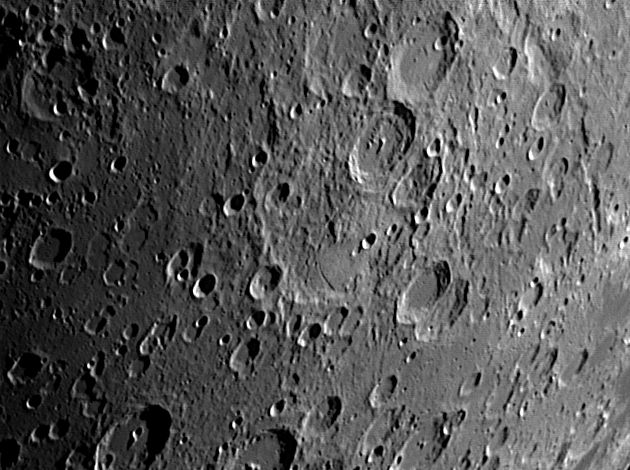

Move your mouse over the picture to see the names of the various features.

This shows the area between Rheita in the north and Vlacq in the south. The largest crater, at 196 Km, and oldest, at 4,200 million years, is Janssen.
Overlaying it to the north is Fabricius, 80 Km in diameter, 2500 metres deep and only about 2,000 million years old. On its northern edge is Metius, 90 Km across and 3000 metres deep and rather older at about 3,900 million years.
Vlacq, to the south, is another old crater at about 4,200 million years; it is 92 Km in diameter and 3000 metres deep.
The scale markers are approximately 100 Km north and west.
The picture was taken on 10th September 2006 when the Moon was 18.4 days old.
Date and Time: 10th September 2006 21:57 UT
Camera: ToUcam 740K
Telescope: LX200
Capture: K3CCDTools. Low gamma, 1/100", 10% gain, 458 frames
Processing: Registax. 12 alignment points, 457 frames stacked. Wavelet 1-2 = 10, gamma 1.5

Janssen is a large (196 Km) and an ancient crater, more than 4,000 million years old, as can be seen from the fact
that it is overlaid by many other craters. The largest of these, Fabricius, is comparatively
young at between 3,200 and 1,000 million years old.
This picture was taken at 14:40 local time (GMT), i.e. in broad daylight, using
infra-red light to reduce the glow from the sky, and it needed considerable
augmentation during processing to increase the contrast, which is poor in the original avi.
The scale markers are approximately 100 Km north and east.
The picture was taken with a ToUcam attached to my LX200 on 11th July 2005 at 14:40 UT, when the Moon was 4.6 days old.
Date and Time: 11th July 2005 14:40 UT
Camera:> ToUcam 740K
Telescope: LX200 at prime focus
Capture: K3CCDTools. Low gamma, 1/33", 41% gain, 312 frames, IR light
Processing: Registax. 183 frames stacked. Wavelet 2-6 = 5, contrast 215, brightness -112, histogram 20-255
PhotoImpact. Unsharp mask, factor 20, aperture 5.

This is a similar area imaged at almost the same phase as the picture at the top but 10 months earlier. Janssen is an interesting feature. It is evidently ancient, overlaid by many other craters. It appears to be filled by debris in the north-west, possibly displaced material from the creation of Fabricius some 2,000 million years later. There is also a very strange cleft running through this debris from the southern edge of Fabricius. Does this cleft curve round and extend to the edge of Janssen close to Janssen D? Another example of slumping caused by an overlapping crater can be seen in Watt. There is a beautiful picture of Watt in Lunar Picture of the Day for 18th January 2006.
This picture was taken on 18th November 2005 when the Moon was 17.6 days old.
Date and Time: 18th November 2005 22:54 UT
Camera: ToUcam 740K
Telescope: LX200
Capture: K3CCDTools. High gamma, 1/50", 8% gain, 514 frames
Processing: Registax. 48 frames stacked. Wavelet 1-2 = 10, gamma 0.8

This is a similar area imaged late in the lunar morning and shows the debris in the north-west part of Janssen more clearly. On the right-hand side of the picture is the southern end of the Rheita Valley, a part sometimes called the Mallet Valley (after the battered crater under the "R" of "Rheita" on my picture). This part is radial to the Nectaris basin, whereas the main Rheita Valley is not. Both were likely caused by ejecta from the formation of the Nectaris basin, and are similar in principle to the crater chains seen radiating from many large craters.
The scale markers are approximately 100 Km north and east.
This picture was taken on 2nd June 2006 when the Moon was 6.4 days old.
Date and Time: 2nd June 2006 21:25 UT
Camera: ToUcam 740K
Telescope: LX200 with IR-pass filter
Capture: K3CCDTools. Low gamma, 1/33", 37% gain, 599 frames
Processing: Registax. 105 frames stacked. Wavelets 1 = 10, 2 = 5, histogram 0-200 Home Back to SE Quadrant